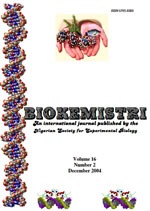
|
Biokemistri
Nigerian Society for Experimental Biology
ISSN: 0795-8080
Vol. 13, No. 1, 2003, pp. 42-50
|
 Bioline Code: bk03007
Bioline Code: bk03007
Full paper language: English
Document type: Research Article
Document available free of charge
|
|
|
Biokemistri, Vol. 13, No. 1, 2003, pp. 42-50
| en |
pH Dependent Prevention Of Carbon Tetrachloride-Induced Lipoperoxidation In Rats By Ethanolic Extract Of Hibiscus rosasinensis  Petal Petal
Obi, F.O. & Uneh, E.
Abstract
The ability of high (6.73) and low (5.02) pH solutions of lead acetate precipitate of H. rosasinensis petal anthocyanin extract to prevent carbon tetrachloride (CCl4) induced lipid peroxidation in rats has been investigated using plasma malondialdehyde (MDA) level as an index of the process. Relative to its value in the plasma of CCl4 treated extract-free rats, the high pH form (pH 6.73; blue pigment) of the resolubilized precipitate significantly (P < 0.05) reduced the level of malondialdehyde in the plasma of rats to which it was administered prior to CCl4 treatment. When compared with CCl4 - treated, extract-free rats, statistically significant (P<0.05) reduction in the level of MDA was also observed in the plasma obtained from rats treated first with the low pH form (pH 5.02; red pigment) of the resolubilized precipitate before CCl4 exposure. These data suggest that H. rosasinensis petal partially purified anthocyanin extract may be protective against carbon tetrachloride-induced lipoperoxidation.
Keywords
Lipoperoxidation, carbon tetrachloride, Anthocyanin, Hibiscus rosasinensis, Malondialdehyde
|
| |
© Copyright 2003 - Nigerian Society for Experimental Biology
|
|
